Hi half an hour ago I was over Wimbledon common walking the dogs..I looked up saw bright blue light as soon as I looked at it it dropped so fast and disappeared...I thought I was seeing things....I have come home and my wife was in the back garden and saw exactly the same thing....what could that have been
Just seen blue light sky
- Thread starter bones209
- Start date
You are using an out of date browser. It may not display this or other websites correctly.
You should upgrade or use an alternative browser.
You should upgrade or use an alternative browser.
Bones209 -
Was the sky cloudy or clear?
Was the blue light in question moving?
Take a look at this story and compare it to your observation...
See: https://www.space.com/bright-fireball-meteor-colorado-video
Hartmann352
Was the sky cloudy or clear?
Was the blue light in question moving?
Take a look at this story and compare it to your observation...
See: https://www.space.com/bright-fireball-meteor-colorado-video
Hartmann352
Last edited:
hi the sky was clear about 6.45.
no it wasn't moving I looked up saw a bright blue light like a big star then dropped about 2 inches In the sky and gone no trail or anything. I have never seen anything like this
no it wasn't moving I looked up saw a bright blue light like a big star then dropped about 2 inches In the sky and gone no trail or anything. I have never seen anything like this
Bones209 -
I can find nothing matching your observed phenomena.
I suggest you keep a close eye on your local media, see if anyone else observed the same phenomena and also check if any scientist/physicist may have an opinion about it.
Usually, it will take a while for similar sightings to hit the print and electronic media because many are afraid of being the first to report, it also takes awhile to bandy it about with the family, friends and even the emergency services before deciding on a course of action on its reporting.
I have always been aware of the skies and yet, despite binoculars and telescopes, I have never observed anything out of the ordinary.
This incident may serve to awaken a similar interest in you. I recommend Nikon binoculars 10 x 50 6.5" to begin your journey of exploration with. I began mine by borrowing a friend's WWII German artillery spotting binoculars. I was amazed and hooked.
Hartmann352
I can find nothing matching your observed phenomena.
I suggest you keep a close eye on your local media, see if anyone else observed the same phenomena and also check if any scientist/physicist may have an opinion about it.
Usually, it will take a while for similar sightings to hit the print and electronic media because many are afraid of being the first to report, it also takes awhile to bandy it about with the family, friends and even the emergency services before deciding on a course of action on its reporting.
I have always been aware of the skies and yet, despite binoculars and telescopes, I have never observed anything out of the ordinary.
This incident may serve to awaken a similar interest in you. I recommend Nikon binoculars 10 x 50 6.5" to begin your journey of exploration with. I began mine by borrowing a friend's WWII German artillery spotting binoculars. I was amazed and hooked.
Hartmann352
thanks for your reply...
I'm going through my head trying to debunk it..
space junk falling? Could it have been a meteorite coming straight on ..
I'm puzzled but amazed to see something like that.....
The last few weeks I have been amazed by how low and bright Venus is at the moment the sky is an amazing thing.....
I will look in to getting some binoculars as I like sky watching in the summer evenings..
thank you
I'm going through my head trying to debunk it..
space junk falling? Could it have been a meteorite coming straight on ..
I'm puzzled but amazed to see something like that.....
The last few weeks I have been amazed by how low and bright Venus is at the moment the sky is an amazing thing.....
I will look in to getting some binoculars as I like sky watching in the summer evenings..
thank you
Hi half an hour ago I was over Wimbledon common walking the dogs..I looked up saw bright blue light as soon as I looked at it it dropped so fast and disappeared...I thought I was seeing things....I have come home and my wife was in the back garden and saw exactly the same thing....what could that have been
The dates are a little out, but have this phenomena -
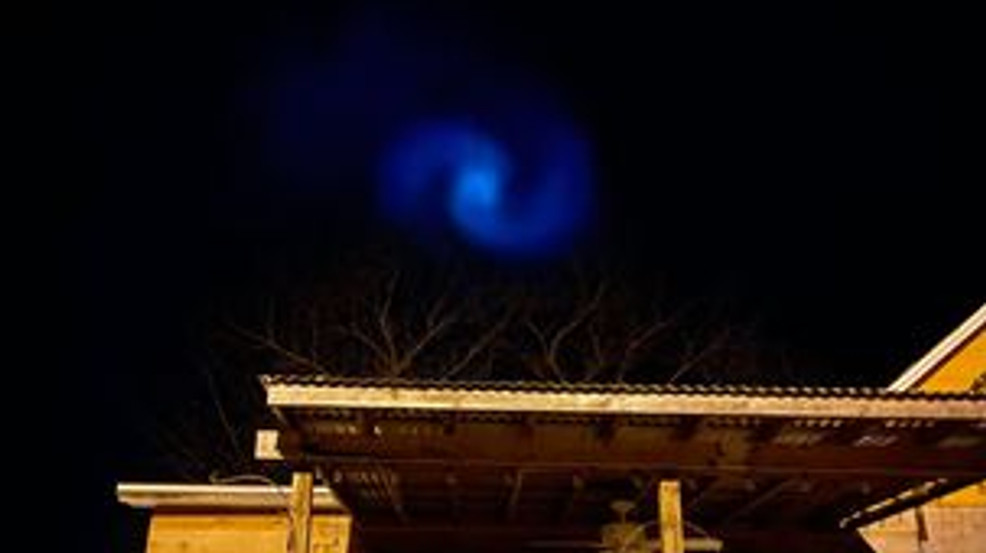
Did you see a swirly blue light in the sky? It was SpaceX
Did you see some weird lights over mid-Missouri on Monday? Several people sent pictures to KRCG showing something in the sky on Monday night. The pictures show a swirling, blue-white glow in the sky. KRCG 13 Meteorologist Zach Paul explains what people saw. "It was the spiral vapor trail from...
Possibility of the way blue light is being dispersed and with the sun rise would disappear quickly, "A Met Office spokesperson told the ECHO: "It'll be for the same reason as sunsets are red, it’s down to 'Rayleigh scattering' of the blue wavelengths of light by cloud or dust in the atmosphere. "

Met Office explain purple skies seen across Merseyside last night
Dusk on Monday evening was quite different than usual
This is possible:
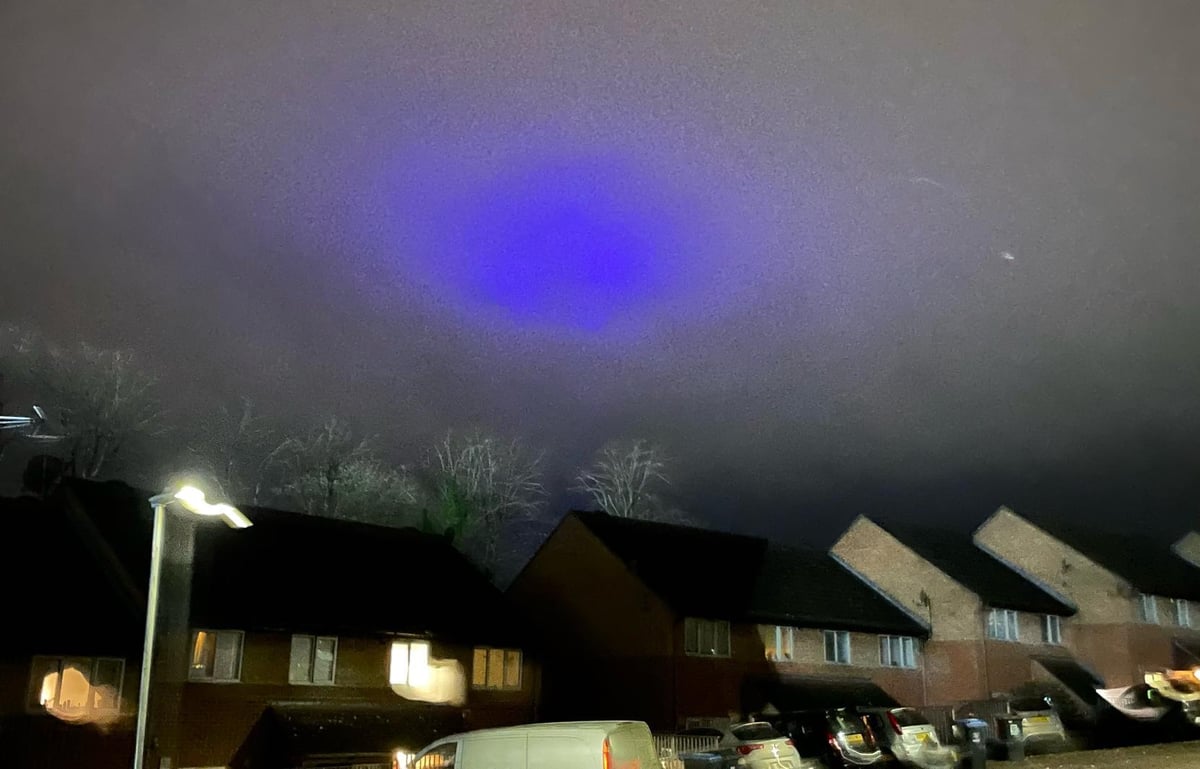
Mysterious blue light spotted over Hemel Hempstead
It was probably a Network Rail test train - and not a UFO
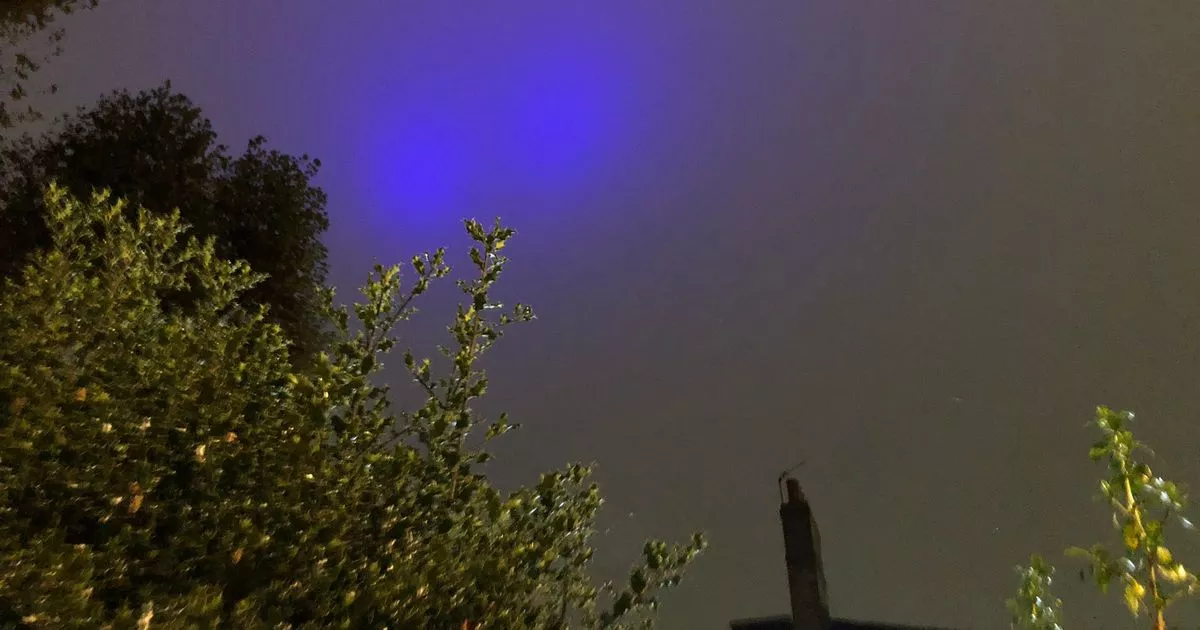
Blue and green lights spotted across London night sky and everyone is asking why
There are multiple theories attempting to explain the phenomenon
This is very likely-
"In a number of other cities blue lights had been seen and Network Rail had said in those areas that it had been caused by a special test train.
The test trains are used to identify faults on the lines with lasers that beam from the train."
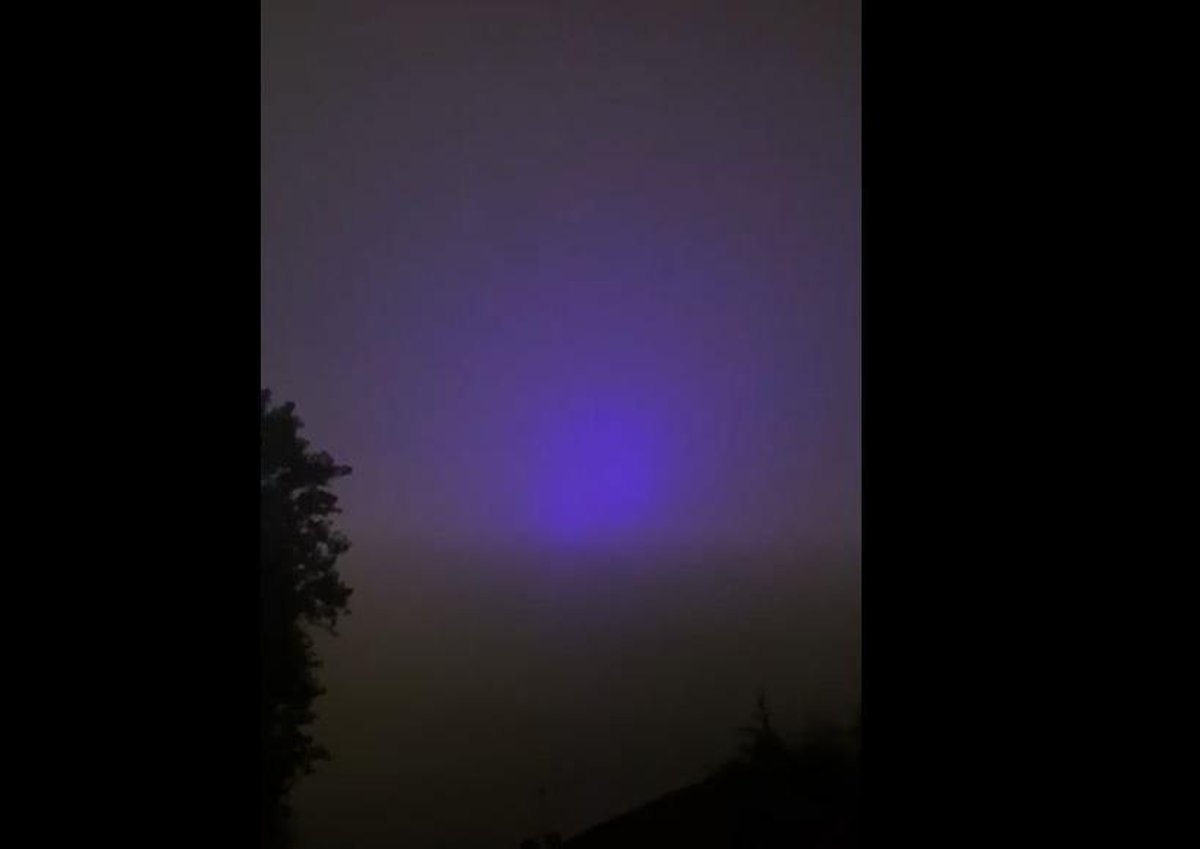
What caused the mysterious bright blue light over Peterborough last night
Residents in Peterborough were baffled on Monday night after a number of reports of a bright blue light in the skies
I have been looking at telescopes on eBay...
There is someone selling an observatory .it looks amazing
There is someone selling an observatory .it looks amazing
I didn't watch the video because it insisted on loading the ad first and took so long,...but I write these things off as Ball lightning (no relation) until or if it is never explained.
The monastery chronicles of a 12th century Benedictine monk named Gervase, who was assigned to the Christ Church Cathedral Priory in Canterbury, wherein physicist Brian Tanner and historian Giles Gasper came upon a striking description of an apparent manifestation of ball lightning. This is the label given to mysterious shining orbs of light that are reported to sometimes appear in the sky, near the ground, and even indoors just before, during, or after thunderstorms.
According to Professors Tanner and Gaspar, this description of June 7, 1195 AD is by far the oldest mention of ball lightning ever found in a manuscript written in England. In fact, the description by the Benedictine Gervase predates the next-earliest reference by nearly 450 years.
Ball lightning has been one of the most mysterious natural phenomena for the intervening centuries, partly because it is so rare and transient and therefore difficult to investigate. But a fortuitous observation during field experiments in China to study ordinary lightning, reported in Physical Review Letters, has now provided what seems to be the first measurement of the emission spectrum of ball lightning. The data suggest that the glowing ball was composed of elements from soil, consistent with one popular theory.
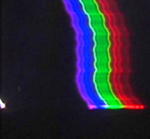
The spectrum of a cloud-to-ground lightning strike and of the ball lightning it generated. The ball lightning is the white dot at the far left, and its spectrum is the slightly brighter band of colors at the foot of the irregularly shaped main lightning spectrum.
Ball lightning typically appears during thunderstorms as a glow, ranging from the size of a golf ball to several meters across, which floats in the air for between one second and tens of seconds. There are many historical reports of such “fireballs” injuring or even killing people and setting buildings alight, and they have sometimes been given supernatural explanations.
Scientific theories of ball lightning abound, with varying degrees of plausibility. Glowing plasma balls have been created artificially by passing intense microwaves through air or by underwater electrical discharges. But such laboratory experiments may not bear any relation to ball lightning formation in the natural environment—about which very little is known, since there has been almost no solid data.
One popular theory is that ball lightning is caused when lightning striking the ground vaporizes some of the silicate minerals in soil. Carbon in the soil strips the silicates of oxygen through chemical reactions, creating a gas of energetic silicon atoms. These then recombine to form nanoparticles or filaments which, while still floating in air, react with oxygen, releasing heat and emitting the glow. If that’s so, one should expect to see atomic emission lines of silicon and other soil elements in the spectrum.
That is what Ping Yuan and co-workers from Northwest Normal University in Lanzhou, China, now report. They had set up spectrometers on the remote Qinghai Plateau of northwest China to investigate ordinary lightning, which is frequent in this region. During one late-evening thunderstorm in July 2012, they saw ball lightning appear just after a lightning strike about 900 meters from their apparatus and were able to record a spectrum and high-speed video footage of the ball.
The recorded glow was about 5 meters across—the actual size of the ball was much smaller—and it changed from white to reddish during the second or so that it lasted. Although the darkness prevented the researchers from estimating the ball’s altitude, they saw it drift horizontally for about 10 meters and ascend about 3 meters. Yuan says that this is the first time ball lightning has been seen to be created by a cloud-to-ground lightning strike.
The researchers found that the spectrum contained several emission lines from silicon, iron, and calcium—all elements expected to be abundant in soil. One would also expect aluminum to be present, given its abundance in soil minerals. But the researchers couldn’t confirm that, as there are no emission lines of neutral aluminum atoms within the spectral range of their instrument (wavelengths of 400–1000 nanometers). The team also used their video data to plot the ball lightning’s intensity and apparent diameter as they varied in time, down to the millisecond time-scale.
One of the most grounded theories regarding ball lightning, proposed by John Abrahamson and James Dinniss of the University of Canterbury in Cristchurch, New Zealand, is that it's caused by lightning striking soil and turning its chemical contents into a vapor. That vapor is said to then condense into a ball of floating aerosol that glows with the heat of the soil's elements mixing with oxygen. Thanks to the spectrograph readings, this theory, first postulated in 2000, now seems all the more plausible.
The findings are not entirely conclusive regarding the nature of ball lightning and not evidence that Abrahamson's theory is universally applicable. For instance, it does not explain how ball lightning can pass through indoor environments like people's homes or inside the cockpit of a plane, as was the case in an instance of ball lightning that passed through the cockpit of a C-133A cargo plane traveling to Hawaii from California. Nor does it address what causes the bang many say to be typical in the evaporation of the glowing orbs.
Led by CSIRO* scientist John Lowke, the new theory focuses on how ball lightning occurs in houses and inside moving aeroplanes – and how it can pass through glass. His theory also proposes that ball lightning is caused when leftover ions (electric energy), which are very dense, are swept to the ground following a lightning strike.
"A crucial proof of any theory of ball lightning would be if the theory could be used to make ball lightning. This is the first paper which gives a mathematical solution explaining the birth or initiation of ball lighting," says Lowke.
Lowke proposes that ball lightning occurs in houses and within aircraft when a stream of ions accumulates on the outside of a glass window and the resulting electric field on the other side excites air molecules to form a ball discharge. The discharge requires a driving electric field of about a million volts.
"Other theories have suggested ball lightning is created by slowly burning particles of silicon formed in a lightning strike, but this is flawed. One of the ball lightning observations cited in this paper occurred when there was no thunderstorm and was driven by ions from the aircraft radar operated at maximum power during a dense fog."
Lowke used eye-witness accounts of ball lightning by two former US Air Force pilots to verify the theory. Former US Air Force lieutenant Don Smith recalls: "After flying for about 15 minutes, there developed on the randome (radar cover) two horns of Saint Elmo's fire. It looked as if the airplane now had bull's horns...they were glowing with the blue of electricity."
Lowke's paper gives the first mathematical solution explaining the birth or initiation of ball lightning using standard equations for the motion of electrons and ions. He argues it is unique because it not only explains the birth of the ball but also how it can form on glass and appear to pass through glass resulting in globes of light in people's homes or in aircraft and jet fighter and bomber cockpits.
See: https://physics.aps.org/articles/v7/5
See: https://www.cnet.com/news/scientists-accidentally-record-ball-lightning-in-nature-for-first-time/
See: https://www.ancient-origins.net/news-history-archaeology/ball-lightning-0016354
* CSIRO or the Commonwealth Scientific and Industrial Research Organisation is an Australian Government agency responsible for scientific research. CSIRO works with leading organisations around the world. From its headquarters in Canberra, CSIRO maintains more than 50 sites across Australia and in France, Chile and the United States, employing about 5,500 people.
We are Australia’s national science organisation and one of the largest and most diverse scientific research organisations in the world. Our research focuses on the biggest challenges facing the nation. We also manage national research infrastructure and collections. (https://research.csiro.au)
I have never seen ball lightning, but I have read about its appearances in heavy weather during long bombing missions during WWII in Europe and during the course of my youthful reading. I am pleased that this unique natural phenomena is finally being winkled out into real physics from the mystical past where it will no longer be called "Foo Fighters" and the like.
Hartmann352
According to Professors Tanner and Gaspar, this description of June 7, 1195 AD is by far the oldest mention of ball lightning ever found in a manuscript written in England. In fact, the description by the Benedictine Gervase predates the next-earliest reference by nearly 450 years.
Ball lightning has been one of the most mysterious natural phenomena for the intervening centuries, partly because it is so rare and transient and therefore difficult to investigate. But a fortuitous observation during field experiments in China to study ordinary lightning, reported in Physical Review Letters, has now provided what seems to be the first measurement of the emission spectrum of ball lightning. The data suggest that the glowing ball was composed of elements from soil, consistent with one popular theory.

The spectrum of a cloud-to-ground lightning strike and of the ball lightning it generated. The ball lightning is the white dot at the far left, and its spectrum is the slightly brighter band of colors at the foot of the irregularly shaped main lightning spectrum.
Ball lightning typically appears during thunderstorms as a glow, ranging from the size of a golf ball to several meters across, which floats in the air for between one second and tens of seconds. There are many historical reports of such “fireballs” injuring or even killing people and setting buildings alight, and they have sometimes been given supernatural explanations.
Scientific theories of ball lightning abound, with varying degrees of plausibility. Glowing plasma balls have been created artificially by passing intense microwaves through air or by underwater electrical discharges. But such laboratory experiments may not bear any relation to ball lightning formation in the natural environment—about which very little is known, since there has been almost no solid data.
One popular theory is that ball lightning is caused when lightning striking the ground vaporizes some of the silicate minerals in soil. Carbon in the soil strips the silicates of oxygen through chemical reactions, creating a gas of energetic silicon atoms. These then recombine to form nanoparticles or filaments which, while still floating in air, react with oxygen, releasing heat and emitting the glow. If that’s so, one should expect to see atomic emission lines of silicon and other soil elements in the spectrum.
That is what Ping Yuan and co-workers from Northwest Normal University in Lanzhou, China, now report. They had set up spectrometers on the remote Qinghai Plateau of northwest China to investigate ordinary lightning, which is frequent in this region. During one late-evening thunderstorm in July 2012, they saw ball lightning appear just after a lightning strike about 900 meters from their apparatus and were able to record a spectrum and high-speed video footage of the ball.
The recorded glow was about 5 meters across—the actual size of the ball was much smaller—and it changed from white to reddish during the second or so that it lasted. Although the darkness prevented the researchers from estimating the ball’s altitude, they saw it drift horizontally for about 10 meters and ascend about 3 meters. Yuan says that this is the first time ball lightning has been seen to be created by a cloud-to-ground lightning strike.
The researchers found that the spectrum contained several emission lines from silicon, iron, and calcium—all elements expected to be abundant in soil. One would also expect aluminum to be present, given its abundance in soil minerals. But the researchers couldn’t confirm that, as there are no emission lines of neutral aluminum atoms within the spectral range of their instrument (wavelengths of 400–1000 nanometers). The team also used their video data to plot the ball lightning’s intensity and apparent diameter as they varied in time, down to the millisecond time-scale.
One of the most grounded theories regarding ball lightning, proposed by John Abrahamson and James Dinniss of the University of Canterbury in Cristchurch, New Zealand, is that it's caused by lightning striking soil and turning its chemical contents into a vapor. That vapor is said to then condense into a ball of floating aerosol that glows with the heat of the soil's elements mixing with oxygen. Thanks to the spectrograph readings, this theory, first postulated in 2000, now seems all the more plausible.
The findings are not entirely conclusive regarding the nature of ball lightning and not evidence that Abrahamson's theory is universally applicable. For instance, it does not explain how ball lightning can pass through indoor environments like people's homes or inside the cockpit of a plane, as was the case in an instance of ball lightning that passed through the cockpit of a C-133A cargo plane traveling to Hawaii from California. Nor does it address what causes the bang many say to be typical in the evaporation of the glowing orbs.
Led by CSIRO* scientist John Lowke, the new theory focuses on how ball lightning occurs in houses and inside moving aeroplanes – and how it can pass through glass. His theory also proposes that ball lightning is caused when leftover ions (electric energy), which are very dense, are swept to the ground following a lightning strike.
"A crucial proof of any theory of ball lightning would be if the theory could be used to make ball lightning. This is the first paper which gives a mathematical solution explaining the birth or initiation of ball lighting," says Lowke.
Lowke proposes that ball lightning occurs in houses and within aircraft when a stream of ions accumulates on the outside of a glass window and the resulting electric field on the other side excites air molecules to form a ball discharge. The discharge requires a driving electric field of about a million volts.
"Other theories have suggested ball lightning is created by slowly burning particles of silicon formed in a lightning strike, but this is flawed. One of the ball lightning observations cited in this paper occurred when there was no thunderstorm and was driven by ions from the aircraft radar operated at maximum power during a dense fog."
Lowke used eye-witness accounts of ball lightning by two former US Air Force pilots to verify the theory. Former US Air Force lieutenant Don Smith recalls: "After flying for about 15 minutes, there developed on the randome (radar cover) two horns of Saint Elmo's fire. It looked as if the airplane now had bull's horns...they were glowing with the blue of electricity."
Lowke's paper gives the first mathematical solution explaining the birth or initiation of ball lightning using standard equations for the motion of electrons and ions. He argues it is unique because it not only explains the birth of the ball but also how it can form on glass and appear to pass through glass resulting in globes of light in people's homes or in aircraft and jet fighter and bomber cockpits.
See: https://physics.aps.org/articles/v7/5
See: https://www.cnet.com/news/scientists-accidentally-record-ball-lightning-in-nature-for-first-time/
See: https://www.ancient-origins.net/news-history-archaeology/ball-lightning-0016354
* CSIRO or the Commonwealth Scientific and Industrial Research Organisation is an Australian Government agency responsible for scientific research. CSIRO works with leading organisations around the world. From its headquarters in Canberra, CSIRO maintains more than 50 sites across Australia and in France, Chile and the United States, employing about 5,500 people.
We are Australia’s national science organisation and one of the largest and most diverse scientific research organisations in the world. Our research focuses on the biggest challenges facing the nation. We also manage national research infrastructure and collections. (https://research.csiro.au)
I have never seen ball lightning, but I have read about its appearances in heavy weather during long bombing missions during WWII in Europe and during the course of my youthful reading. I am pleased that this unique natural phenomena is finally being winkled out into real physics from the mystical past where it will no longer be called "Foo Fighters" and the like.
Hartmann352
Bones209 -
This may not relate to your earlier observation, however it is of note...
A week-long mystery has just been solved. On Tuesday, March 29th, webcams and sky watchers in the interior of Alaska, witnessed a strange blue ball of light cut across the night sky. "It seemed like it had something that was spinning inside," Fairbanks photographer Leslie Smallwood told local news station KUAC. Physicists at the University of Alaska Fairbanks had no explanation--except it looked gaseous.
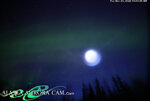
An aurora webcam snapshot of the luminous blue ball. Credit: Marketa S. Murray
The explanation, it turns out, may be traced back to the Taiyuan Satellite Launch Center in northern China. Jonathan McDowell, an astronomer at the Harvard Smithsonian Center for Astrophysics in Boston says sightings of the orb in Alaska match the flight of a Chinese satellite.
"I am very confident that what people saw was the dumping of fuel from a Chinese rocket stage," he explains. "This rocket — the Longmarch 6A or Chang Zheng 6A — was launched early on March 29 from China, placed 2 satellites in orbit and, calculating its orbital path, it passed over the Yukon area about 350 miles up at exactly the time that this glow was seen in the Alaskan sky."
According to spacetoday.net: The rocket lifted off from the Taiyuan Satellite Launch Center at 5:50 am EDT (0950 GMT) and placed two satellites into sun-synchronous orbits. The Long March 6A is a more powerful version of the Long March 6, with four solid-fuel strap-on boosters and two engines in its first stage. The two satellites, Pujiang 2 and Tiankun 2, will conduct Earth imaging and space environment missions.
Eyewitnesses said the orb was bigger than a full Moon. In fact, the cloud was a few hundred miles across. The tumbling rocket booster released its unused fuel into space where it expanded into a nearly spherical cloud of frozen propellant, reflecting high-altitude sunlight above Earth's atmosphere.
See: https://spacetoday.net/Summary/7711
See: https://spaceweather.com
This may not relate to your earlier observation, however it is of note...
A week-long mystery has just been solved. On Tuesday, March 29th, webcams and sky watchers in the interior of Alaska, witnessed a strange blue ball of light cut across the night sky. "It seemed like it had something that was spinning inside," Fairbanks photographer Leslie Smallwood told local news station KUAC. Physicists at the University of Alaska Fairbanks had no explanation--except it looked gaseous.

An aurora webcam snapshot of the luminous blue ball. Credit: Marketa S. Murray
The explanation, it turns out, may be traced back to the Taiyuan Satellite Launch Center in northern China. Jonathan McDowell, an astronomer at the Harvard Smithsonian Center for Astrophysics in Boston says sightings of the orb in Alaska match the flight of a Chinese satellite.
"I am very confident that what people saw was the dumping of fuel from a Chinese rocket stage," he explains. "This rocket — the Longmarch 6A or Chang Zheng 6A — was launched early on March 29 from China, placed 2 satellites in orbit and, calculating its orbital path, it passed over the Yukon area about 350 miles up at exactly the time that this glow was seen in the Alaskan sky."
According to spacetoday.net: The rocket lifted off from the Taiyuan Satellite Launch Center at 5:50 am EDT (0950 GMT) and placed two satellites into sun-synchronous orbits. The Long March 6A is a more powerful version of the Long March 6, with four solid-fuel strap-on boosters and two engines in its first stage. The two satellites, Pujiang 2 and Tiankun 2, will conduct Earth imaging and space environment missions.
Eyewitnesses said the orb was bigger than a full Moon. In fact, the cloud was a few hundred miles across. The tumbling rocket booster released its unused fuel into space where it expanded into a nearly spherical cloud of frozen propellant, reflecting high-altitude sunlight above Earth's atmosphere.
See: https://spacetoday.net/Summary/7711
See: https://spaceweather.com
Similar threads
- Replies
- 0
- Views
- 840
- Replies
- 0
- Views
- 682
- Replies
- 1
- Views
- 876
TRENDING THREADS
-
-
Pluto's huge white 'heart' has a surprisingly violent origin, new study suggests
- Started by admin
- Replies: 0
-
What is a living individual and is it naturally universally mobile?
- Started by tonylang
- Replies: 137
-
Most massive stellar black hole in the Milky Way discovered 'extremely close' to Earth
- Started by admin
- Replies: 0
-
Important Astronomy - No elliptic orbit and relativity break through
- Started by TheBox
- Replies: 63
Latest posts
-
Transforming Healthcare: The Benefits of AI in the Medical Care Industry
- Latest: DalvkotInfotech
-
-

Live Science is part of Future plc, an international media group and leading digital publisher. Visit our corporate site.
© Future Publishing Limited Quay House, The Ambury, Bath BA1 1UA. All rights reserved. England and Wales company registration number 2008885.
